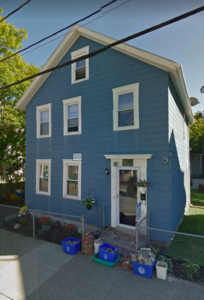

Lewis Temple House
54 Bedford Street, New Bedford, MA
Lewis Temple invented a harpoon that revolutionized American whaling, the toggle iron. This harpoon was designed to decrease the chance of slipping out of a harpooned whale; its point swiveled so that it locked into the whale. This was considered one of the few true technological innovations in whaling in the 1800s. However, Temple did not patent his invention and other blacksmith shops profited from producing toggle harpoons. James Durfee’s shop produced some thirteen thousand Temple toggle irons from its invention through 1868.
Temple is believed to have been born in Richmond, Virginia where he was formerly enslaved. By 1829 he had moved to New Bedford, where he established a blacksmith shop. Temple lived at 54 Bedford Street from at least 1836 through the mid-1840s, when he moved closer to his shop on the waterfront at Coffin Wharf and Walnut Street. His niece, Mary Clark, moved here with her Cape Verdean husband, Miguel Fortes, also a blacksmith. Although Fortes is now a common last name, Miguel may have been among the first Fortes in New Bedford. Temple’s son Lewis Jr. was born about 1830. He became a blacksmith, and worked for Dean and Driggs at the foot of Walnut Street; later he became a barber, another well-respected occupation among people of color. Temple died in 1854 as the result of an accident near the new shop the New Bedford firm of Delano and Pierce was then building for him at the foot of School Street.
Local history and self-guided tours are presented in collaboration with the New Bedford Historical Society and the New Bedford Whaling National Historical Park. Visitors can also access interactive digital components, VR tours, and videos originally created for the New Bedford Historical Society and UMass Dartmouth’s exhibition, Black Spaces Matter: Celebrating New Bedford’s Abolition Row.
This exhibition will be shown free and open to the public in downtown New Bedford outdoors at the YMCA green space on Union Street, between N. 2nd Street and N. Water Street from June 16 to September 12.
CREDITS
The Black Spaces Matter project is collaboration between UMass Dartmouth College of Visual and Performing Arts students and faculty, local New Bedford experts, and the New Bedford Historical Society.
Black Spaces Matter was exhibited from November 19, 2017 — January 29, 2018 at the Boston Architectural College’s McCormack Gallery, 320 Newbury St. Boston, MA, and from November 8, 2018 — January 30, 2019 at UMass Dartmouth’s University Gallery, 715 Purchase St. New Bedford, MA 02740.
SUPPORT
Black Spaces Matter is supported by New Bedford Historical Society, Creative Economy Fund from the Office of the UMass President, UMass Dartmouth Provost Office, Perkins + Will Associates, Rotch–Jones–Duff House and Garden Museum, Spinner Publications, New Bedford Whaling National Historical Park.
PARTICIPANTS
Consultant: Lee Blake | Lead curator: Pamela Karimi | Architectural renderings, model production, and maps: Pedram Karimi and students in Architecture and Sustainability class | Film, animation, and digital curation: Don Burton | Artistic representations: Michael Swartz | Consultants for the Documentaries: Janine da Silva, Ann Marie Lopes | Advertisement and graphic design: Ziddi Msangi, Racsa Soun, Vasco Pedro and students in Community Engagement Design studio | Digital stations: Michael Swartz, Don Burton, Ben Guan-Kennedy, and Merri Cyr | Production Manager: Jennifer McGrory | Curatorial assistance: CVPA students, Cynthia Raposa, Mark Walker, and gallery director, Viera Levitt.
CREDITS
The Black Spaces Matter project is collaboration between UMass Dartmouth College of Visual and Performing Arts students and faculty, local New Bedford experts, and the New Bedford Historical Society.
Black Spaces Matter was exhibited from November 19, 2017 — January 29, 2018 at the Boston Architectural College’s McCormack Gallery, 320 Newbury St. Boston, MA, and from November 8, 2018 — January 30, 2019 at UMass Dartmouth’s University Gallery, 715 Purchase St. New Bedford, MA 02740.
SUPPORT
Black Spaces Matter is supported by New Bedford Historical Society, Creative Economy Fund from the Office of the UMass President, UMass Dartmouth Provost Office, Perkins + Will Associates, Rotch–Jones–Duff House and Garden Museum, Spinner Publications, New Bedford Whaling National Historical Park.
PARTICIPANTS
Consultant: Lee Blake | Lead curator: Pamela Karimi | Architectural renderings, model production, and maps: Pedram Karimi and students in Architecture and Sustainability class | Film, animation, and digital curation: Don Burton | Artistic representations: Michael Swartz | Consultants for the Documentaries: Janine da Silva, Ann Marie Lopes | Advertisement and graphic design: Ziddi Msangi, Racsa Soun, Vasco Pedro and students in Community Engagement Design studio | Digital stations: Michael Swartz, Don Burton, Ben Guan-Kennedy, and Merri Cyr | Production Manager: Jennifer McGrory | Curatorial assistance: CVPA students, Cynthia Raposa, Mark Walker, and gallery director, Viera Levitt.
Events

Community Volunteer Day
Join us in our last stages of creating a community-made public art piece celebrating Pride in SouthCoast Massachusetts. We’re calling on community members to help us bring Being Seen to life! Whether you’re into painting, crafting, organizing, or just want to lend a hand, there’s something for everyone. ✂️ Materials Provided – Paint, fabric, collage supplies & more (while they
